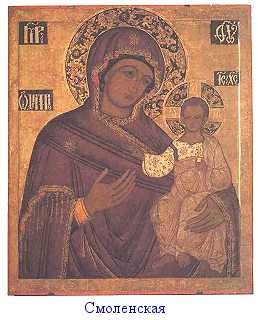Smolensk icon of Mother of God
The Smolensk Icon of the Mother of God has been known in Russia since the mid-llth century. In 1046, Byzantine Emperor Constantine Monomachus blessed his daughter Anne with this holy image when she departed for Kievan Rus to her future husband, Prince Vsevolod I Yaroslavich of Pereyaslavl". It is considered to be the first Byzantine icon of the Mother of God ever to be brought to Russia. In the early 12th century, Vladimir Monomakh, the son of Vsevolod I Yaroslavich. moved the Hodegetria to Smolensk and installed it in the Cathedral of the Dormition of the Most Holy Theotokos. It was since that time that it came to be known as the Smolensk Icon of the Mother of God "Hodegetria." In 1414, Prince Yuri Svyatoslavich of Smolensk, escaping from advancing Lithuanian troops, fled to Moscow, having taken the holy image along with him. In Moscow, it was placed in the Cathedral of the Annunciation in the Kremlin. In 1456, at the request of the Smolensk people, Grand Duke Vassily the Dark of Muscovy returned icon to them, after having ordered an exact copy of the icon to be made to replace the miracle-working original in the Cathedral of the Annunciation. In 1524. to commemorate the winning of Smolensk back from the Lithuanians, the Novodevichy Convent with a Cathedral of the Smolensk Icon of the Mother of God was built in Moscow, and that was where the holy image was finally installed. Since that time, a Russian nationwide festival, the Feast of the Smolensk Icon of the Mother of God "Hodegetria," has been celebrated annually on July 28/August 10.

